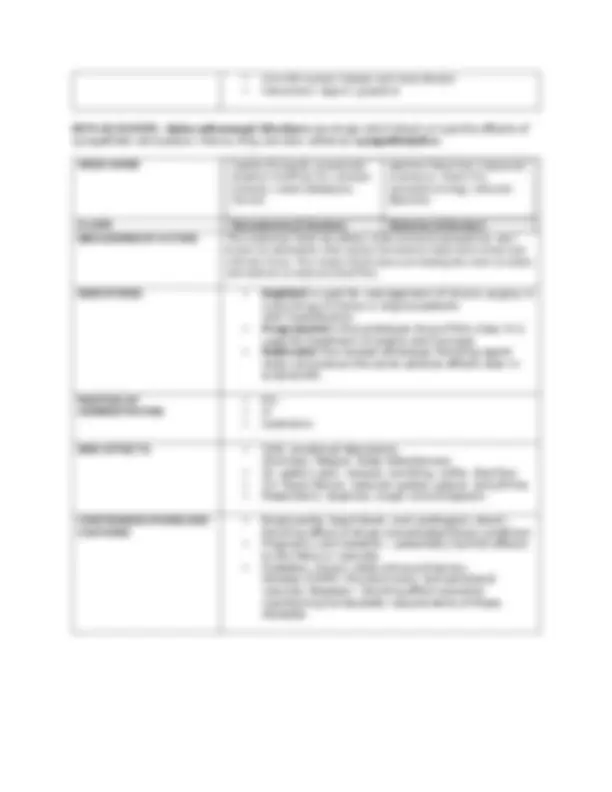



Study with the several resources on Docsity

Earn points by helping other students or get them with a premium plan


Prepare for your exams
Study with the several resources on Docsity

Earn points to download
Earn points by helping other students or get them with a premium plan
Community
Ask the community for help and clear up your study doubts
Discover the best universities in your country according to Docsity users
Free resources
Download our free guides on studying techniques, anxiety management strategies, and thesis advice from Docsity tutors
The topic was all about drugs specifying their pharmacodynamics, pharmacokinetics, dosage and more
Typology: Summaries
1 / 3

This page cannot be seen from the preview
Don't miss anything!


ANTIANGINAL AGENTS - Antianginal agents is a term used to describe a wide variety of medicines that are used in the management of angina. Angina is a heart condition characterized by a narrowing of the coronary arteries (the arteries of the heart). Chest pain is its main symptom. Common Antianginal Drugs NITRATES - Nitrates are antianginal agents that provide fast action to directly relax smooth muscles and depress muscle tone without affecting nerve activity. DRUG NAME nitroglycerin (e.g., Nitrolingual, Nitro-Bid, Nitro-Dur, NitroMist); isosorbide dinitrate; isosorbide mononitrate CLASS Nitrates MECHANISM OF ACTION Relax vascular smooth muscle cells, thereby causing venous and arterial vasodilation; decrease both preload and afterload; relax coronary arteries It compensates by increasing blood flow to healthy arteries and veins because affected vessels already lose their elasticity. INDICATIONS Mainly angina pectoris, hypertension, heart failure, anal fissure. Children : May be used only for congenital heart defects and cardiac surgery because they can cause potentially dangerous changes in blood pressure. Use during pregnancy is not established. Sublingual nitroglycerin is most effective for recurrent variant angina. Continuous infusion or transdermal patch for unstable angina. ROUTE/S OF ADMINISTRATION Nitroglycerin S/L PO, PO spray IV Transdermal patch Topical ointment PR Isosorbide dinitrate, isosorbide mononitrate PO SIDE EFFECTS CNS: throbbing headache, dizziness, weakness
GI: nausea, vomiting, incontinence CV: hypotension, reflex tachycardia, syncope EENT: pallor, flushing, sweating Large dose leads to methemoglobinemia and cyanosis. CONTRAINDICATIONS AND CAUTIONS Hypotension, hypovolemia, severe anemia, cardiomyopathy Use carefully during pregnancy, breastfeeding, children or elderly, increased intracranial pressure, cerebral hemorrhage, renal or hepatic disease, and syncope Drug interactions: other vasodilators (i.e., alcohol or erectile dysfunction medication like sildenafil, tadalafil, or vardenafil) CALCIUM ANTAGONIST - Calcium-channel blockers are drugs which block heart contraction by inhibiting movement of calcium ions, thereby altering arterial and cardiac muscle action potentials. It serves as a substitute for classic and variant angina when beta-blockers and nitrates are contraindicated. DRUG NAME Dihydropyridines : nifedipine (Procardia, Adalat), amlodipine (Norvasc), clevidipine (Cleviprex), nicardipine (Cardene), felodipine (Plendil), nimodipine (Nimotop) Non-dihydropyridines : diltiazem (Cardizem), verapamil (Calan, Isoptin) CLASS Calcium Channel Blockers (CCB) MECHANISM OF ACTION Block the entry of calcium into the cells Reduce the contraction of vascular smooth muscle and cardiac muscle o Dilate arterioles, and reduce blood pressure and peripheral vascular resistance o Dilate coronary vessels and increase oxygen supply to the heart o Reduce force of contraction of cardiac muscles and reduce oxygen demand of the heart Reduce the firing and conduction of impulse through the SA and AV nodes in the heart INDICATIONS Cardiac arrhythmia, hypertension, angina pectoris, tocolysis in preterm labor, Raynaud’s phenomenon, migraine prophylaxis Nimodipine: subarachnoid hemorrhage ROUTE/S OF ADMINISTRATION
SIDE EFFECTS CNS: dizziness, lightheadedness, fatigue, and headache GI: nausea, hepatotoxicity effect of the drug CV: hypotension, bradycardia, peripheral edema EENT: flushing, rash CONTRAINDICATIONS AND CAUTIONS Pre-existing bradycardia Heart block Heart failure